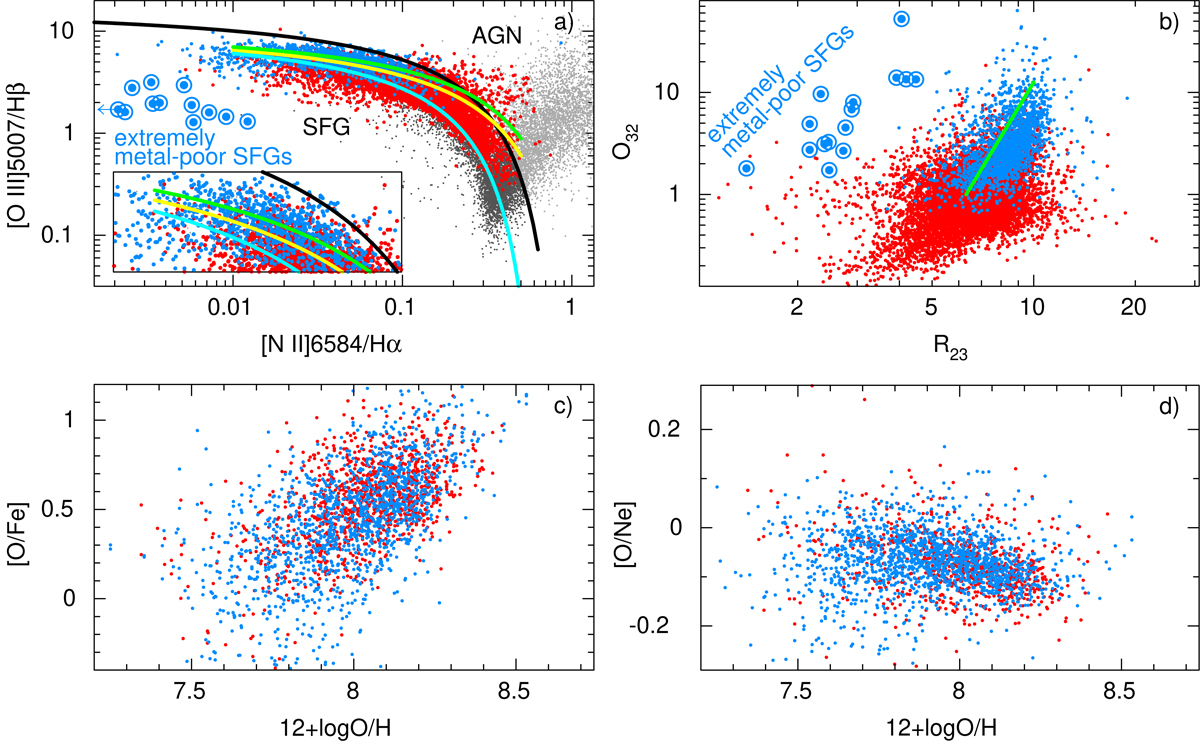Fig. 1.

(a) [O III] λ5007/Hβ vs. [N II] λ6584/Hα BPT diagram (Baldwin et al. 1981) for SDSS DR16 CSFGs with EW(Hβ) ≥ 100 Å (blue dots) and with EW(Hβ) < 100 Å (red dots). The SDSS DR7 galaxies including both SFGs (without constraints used for selection of CSFGs) and AGN are represented by dark grey dots and light grey dots, respectively. The black line (Kauffmann et al. 2003) separates SFGs from AGN, whereas the cyan line by Kewley et al. (2013) represents the best fit relation for the total sample of z ∼ 0 SFGs from the SDSS DR7. Yellow and green lines indicate relations for z ∼ 2–3 SFGs by Shapley et al. (2015) and Strom et al. (2017), respectively. An expanded version of the upper part of the diagram in the ranges [N II]λ6584/Hα of 0.006–0.16 and [O III] λ5007/Hβ of 4–8 is shown in the inset. (b) Relation O32 − R23, where O32 = [O III] λ5007/[O II] λ3727, R23 = ([O III] λ4959 + [O III] λ5007 + [O II] λ3727)/Hβ. The green line represents the relation for z ∼ 2–3 SFGs by Strom et al. (2017). The most metal-poor nearby galaxies with 12 + log O/H ∼ 6.9–7.25 (Izotov et al. 2018c, and in prep.; Kojima et al. 2020) are shown in (a) and (b) by encircled blue-filled circles. (c) Dependence of the oxygen overabundance [O/Fe] ≡ log(O/Fe) − log(O/Fe)⊙ on the oxygen abundance 12 + logO/H. (d) Dependence of [O/Ne] ≡ log(O/Ne) − log(O/Ne)⊙ on the oxygen abundance 12 + logO/H. Abundances are derived using the Te-method. About ∼2300 galaxies with detected [O III]λ4363 emission and an error less than 25% of the line flux are shown in (c) and (d). The meanings of the symbols for SDSS galaxies in (b)–(d) are the same as in (a).
Current usage metrics show cumulative count of Article Views (full-text article views including HTML views, PDF and ePub downloads, according to the available data) and Abstracts Views on Vision4Press platform.
Data correspond to usage on the plateform after 2015. The current usage metrics is available 48-96 hours after online publication and is updated daily on week days.
Initial download of the metrics may take a while.


